Looking for a basil cake recipe that’ll wow your guests? This unique dessert combines aromatic herbs with sweet indulgence – an unexpected pairing that creates pure magic on your palate.
Basil cake transforms the beloved herb from its usual savory applications into a delightful sweet treat. The bright, slightly peppery notes of fresh basil perfectly complement the sweetness of cake batter, creating a sophisticated flavor profile that’s both surprising and addictive. You’ll find that this herb-infused dessert offers a refreshing alternative to traditional cakes.
Whether you’re harvesting basil from your garden or picking up a bunch from the farmers market, this recipe puts your fresh herbs to delicious use. The vibrant green flecks throughout the cake not only add visual appeal but infuse every bite with basil’s distinctive aroma.
What Makes This Basil Cake Special
This basil cake stands out from traditional desserts in several remarkable ways. The unexpected marriage of herbaceous basil with sweet cake creates a sophisticated flavor profile that surprises and delights with each bite.
Fresh basil leaves infuse the batter with their aromatic oils releasing complex notes that transform as they bake. Unlike other herb-infused desserts this cake achieves perfect balance where the basil complements rather than overwhelms the sweetness.
The vibrant green specks throughout the cake offer visual interest making it an instant conversation starter at any gathering. Your guests will be intrigued by the unusual ingredient before they even take their first taste.
The texture deserves special mention too. This cake maintains a tender crumb with a slight density that supports the basil flavor beautifully. The moisture level stays perfect for days thanks to the natural oils in the herb.
Versatility is another standout quality. This basil cake pairs wonderfully with seasonal fruits adapting to different seasons. Try it with summer berries fresh peaches or autumn pears for delightful variations.
For those who appreciate unique desserts this recipe offers something truly distinctive. The familiar comfort of cake meets the unexpected sophistication of basil creating a dessert that feels both innovative and timeless.
Ingredients You’ll Need

Creating this extraordinary basil cake requires fresh ingredients that balance herbal notes with sweet elements. Gather these components before beginning your baking adventure.
For the Basil Cake
- 2 cups all-purpose flour
- 1½ teaspoons baking powder
- ½ teaspoon baking soda
- ¼ teaspoon salt
- ½ cup unsalted butter at room temperature
- 1½ cups granulated sugar
- 3 large eggs at room temperature
- 1 cup fresh basil leaves tightly packed (about 1 ounce)
- ¼ cup whole milk
- ¾ cup buttermilk
- 1 teaspoon vanilla extract
- Zest of 1 lemon
For the Frosting
- 8 ounces cream cheese softened
- ½ cup unsalted butter at room temperature
- 3 cups powdered sugar sifted
- 2 tablespoons finely chopped fresh basil
- 1 tablespoon lemon juice
- ½ teaspoon vanilla extract
- Pinch of salt
- Fresh basil leaves for garnish (optional)
- Lemon zest for garnish (optional)
Kitchen Tools Required
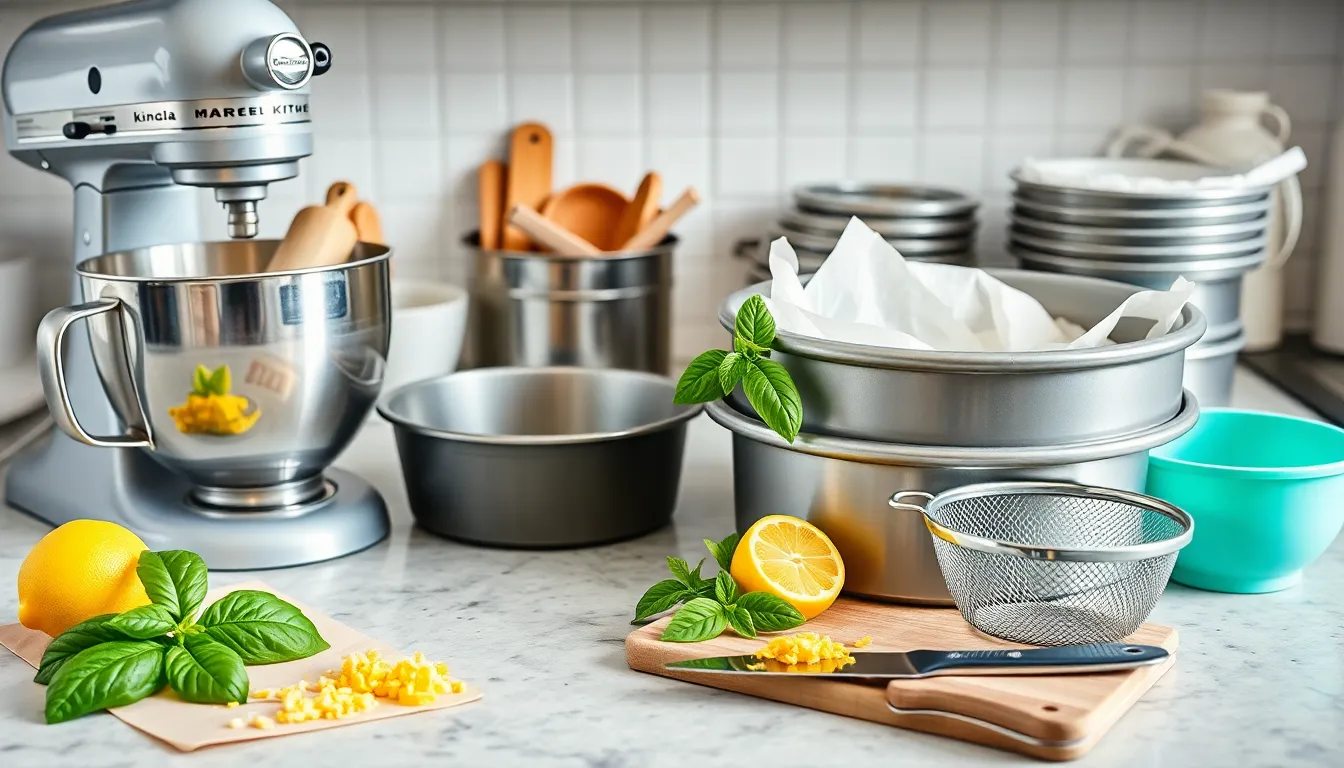
Preparing your basil cake requires exact tools to ensure success. Gather these essential items before starting:
- Mixing bowls – You’ll need at least two: one large bowl for combining dry ingredients and another for wet ingredients
- Stand mixer or hand mixer – Essential for properly creaming butter and sugar and achieving the perfect batter consistency
- Measuring cups and spoons – For accurate measurement of both dry and liquid ingredients
- 9-inch round cake pans – Two pans allow you to create a layered cake (or use a single pan for a simpler version)
- Parchment paper – Line your cake pans to prevent sticking and ensure easy removal
- Rubber spatula – Helps scrape down the sides of bowls and fold in basil without crushing it
- Chef’s knife and cutting board – For finely chopping fresh basil leaves
- Fine mesh strainer or sifter – Ensures your dry ingredients are lump-free
- Cooling rack – Allows your cake to cool evenly without condensation forming
- Offset spatula – Makes frosting your cake much easier and more professional-looking
- Zester or microplane – For preparing the lemon zest that brightens the basil flavor
- Food processor – Optional but helpful for finely processing basil for the batter
Having these tools readily available streamlines your baking process and helps achieve the perfect texture and presentation for your basil cake. Each tool serves a exact purpose in bringing out the unique herbal notes while maintaining the cake’s delicate structure.
How to Make Basil Cake
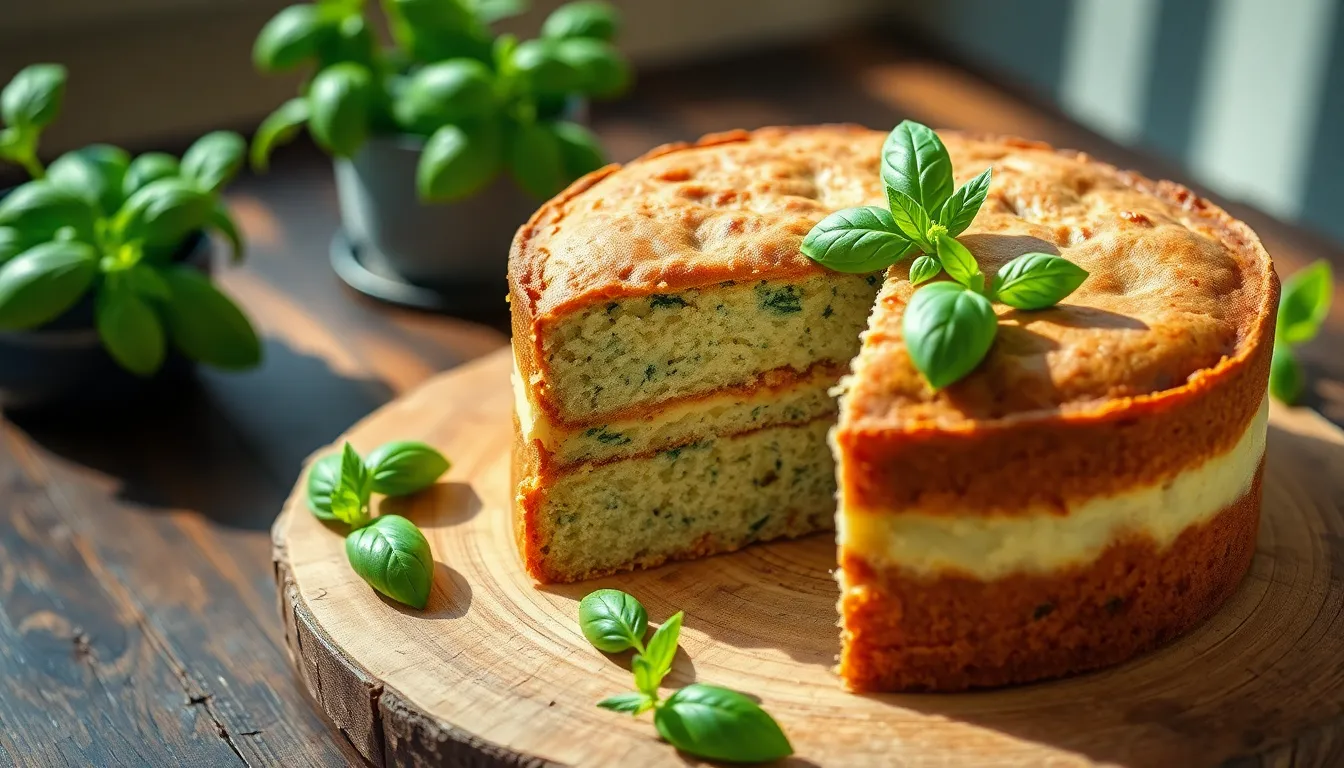
Transform fresh basil into a stunning cake with these straightforward instructions. Follow each step carefully to achieve that perfect balance of herbaceous flavor and sweet indulgence.
Preparing the Basil
Select 1 cup of fresh basil leaves with vibrant green color and no brown spots. Rinse the leaves thoroughly under cold water to remove any dirt or residue. Pat them completely dry using paper towels or a clean kitchen towel to prevent excess moisture from affecting your cake batter. Remove any tough stems and stack the leaves together before chopping them finely with a sharp knife. For optimal flavor infusion prepare a basil paste by blending ½ cup of the chopped leaves with 2 tablespoons of milk using a food processor until smooth. Reserve the remaining chopped basil for the frosting and garnish. This preparation technique ensures the basil flavor distributes evenly throughout your cake while maintaining its aromatic properties.
Making the Cake Batter
Preheat your oven to 350°F (175°C) and prepare two 9-inch round cake pans by greasing them and lining with parchment paper. Whisk together 2½ cups all-purpose flour baking powder baking soda and salt in a medium bowl until well combined. Beat 1 cup unsalted butter in a large mixing bowl until creamy then gradually add 1¾ cups granulated sugar beating for 3-4 minutes until light and fluffy. Add 3 eggs one at a time ensuring each is fully incorporated before adding the next. Mix in the basil paste and 1 teaspoon vanilla extract until the batter turns slightly green with visible basil specks. Combine ½ cup whole milk with ½ cup buttermilk in a measuring cup. Alternate adding the dry ingredients and milk mixture to your butter mixture starting and ending with the dry ingredients (three additions of dry two of wet). Fold in 1 tablespoon lemon zest with a rubber spatula using gentle strokes to maintain the batter’s airiness.
Baking Instructions
Divide the batter evenly between your prepared cake pans using a kitchen scale for precision if available. Smooth the tops with an offset spatula to ensure even baking. Tap each pan gently on the counter to release any trapped air bubbles. Place both pans on the middle rack of your preheated oven ensuring at least 2 inches of space between them for proper air circulation. Bake for 25-30 minutes or until a toothpick inserted into the center comes out clean with a few moist crumbs. The cake tops should spring back when lightly touched and appear golden around the edges. Allow the cakes to cool in their pans for exactly 10 minutes before transferring to a wire cooling rack. Remove the parchment paper and let them cool completely for at least 1 hour before frosting. This cooling period is crucial as it allows the basil flavor to develop fully while ensuring the cake structure sets properly.
Frosting Your Basil Cake
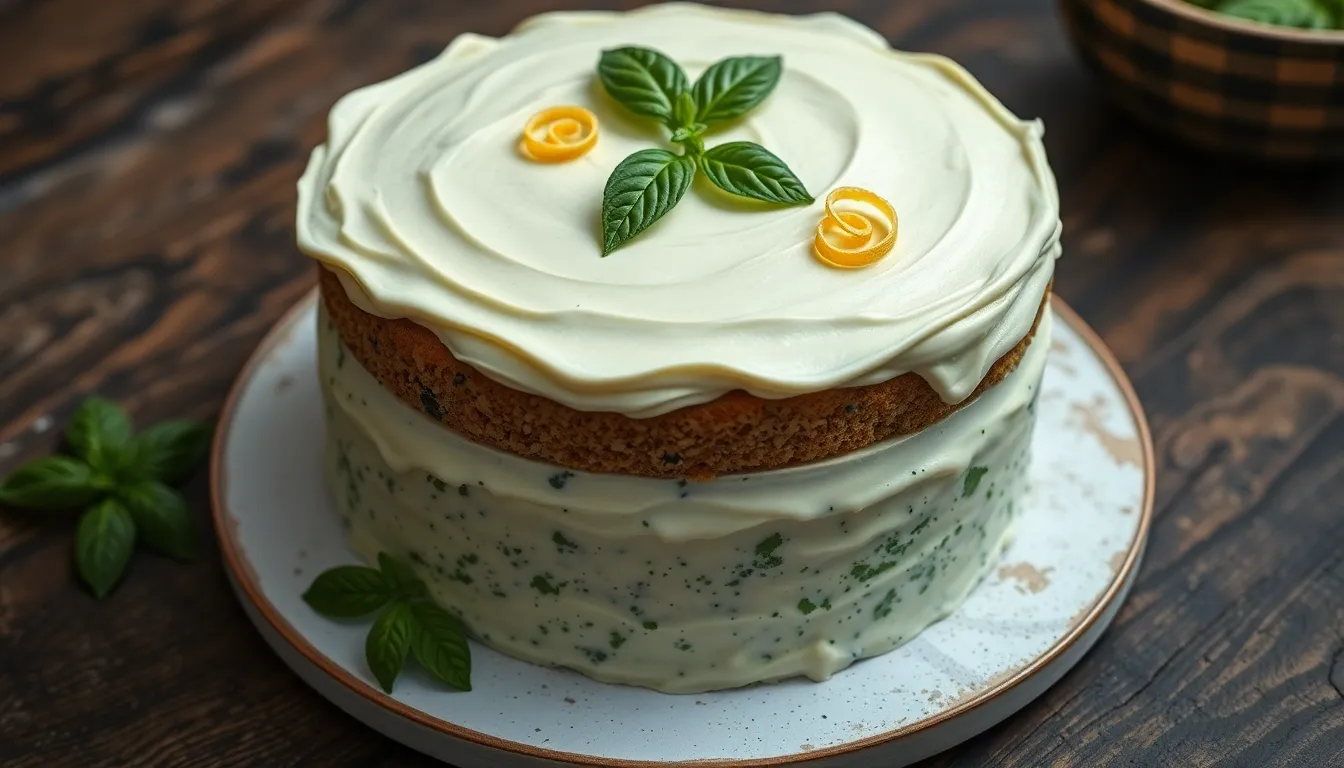
After your basil cake layers have completely cooled, it’s time to create and apply the cream cheese frosting that will complement the herbaceous notes of your cake. Begin by ensuring your cream cheese and butter are at room temperature for a smooth consistency. Beat these ingredients together until fluffy using your stand mixer or hand mixer at medium speed for about 2-3 minutes.
Gradually add powdered sugar to the cream cheese mixture, incorporating it one cup at a time to prevent a sugary cloud from forming. Mix until completely smooth, then fold in the finely chopped fresh basil leaves and a squeeze of lemon juice. The basil should be chopped as finely as possible to distribute evenly throughout the frosting without creating large chunks.
Apply a thin layer of frosting between your cake layers, known as a crumb coat. This initial layer seals in any loose crumbs before you add the final frosting. Place your assembled cake in the refrigerator for 15-20 minutes to allow this first layer to set.
Remove the chilled cake and apply the remaining frosting with an offset spatula, working from the top down to the sides. Create decorative swirls or patterns if desired, or keep it rustic with simple texture. The pale cream color of the frosting provides a beautiful contrast to the speckled green cake interior.
For a professional finishing touch, garnish your frosted cake with small basil leaves, twisted lemon zest curls, or edible flowers. These decorative elements not only enhance the visual appeal but also hint at the flavors waiting inside. Store your finished basil cake in the refrigerator until about 30 minutes before serving to allow the frosting to soften slightly and the flavors to shine through.
Flavor Variations and Add-ins
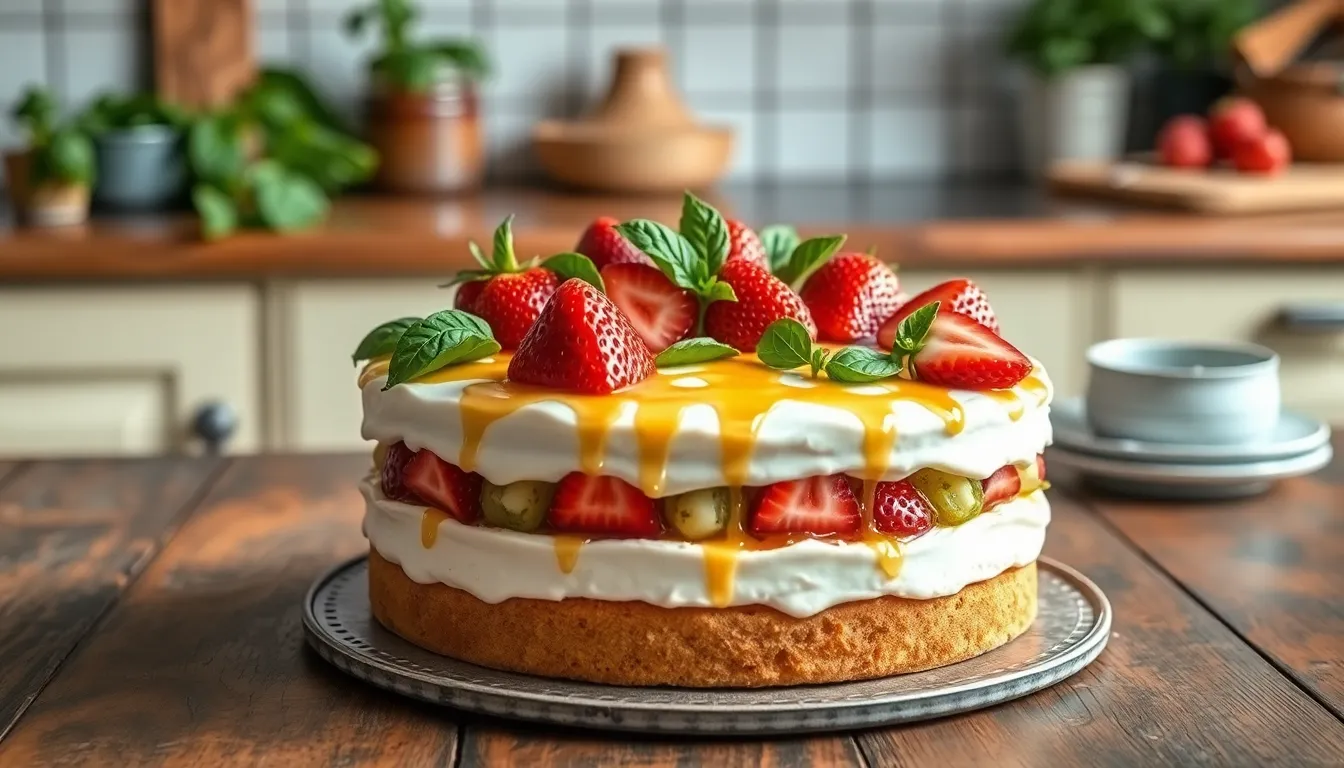
While the classic basil cake is already a showstopper you can easily customize it to suit different seasons or preferences. Try these exciting variations to transform your basil cake into something even more special:
Herb Combinations
Basil pairs beautifully with other herbs for more complex flavor profiles. Mint adds a cooling freshness that works especially well during summer months. Lemon thyme introduces subtle citrus notes that enhance the existing lemon zest in the recipe. Lavender creates an elegant floral dimension though use it sparingly as it can quickly overpower. Consider replacing 1/3 of the basil with your secondary herb for a balanced flavor that maintains the basil as the star ingredient.
Fruit Infusions
Fresh seasonal fruits elevate your basil cake to new heights. Strawberries and basil form a classic pairing – fold 1 cup of diced strawberries into your batter or layer sliced berries between cake layers. Peaches provide a summery sweetness that complements the herbaceous notes perfectly. Raspberries offer tart contrast against the aromatic basil. Blueberries bring antioxidant-rich bursts of flavor throughout the cake. For any fruit addition fold in 1-1½ cups gently after combining your wet and dry ingredients to prevent overmixing.
Citrus Variations
Different citrus elements can dramatically shift your basil cake’s flavor profile. Orange zest creates a warmer Mediterranean-inspired dessert compared to the brightness of lemon. Lime zest introduces a tropical undertone that works beautifully with basil. Blood orange provides subtle berry notes along with its citrus character. Key lime delivers an intensely tart punch that balances the sweet cake base. Substitute the lemon zest in the original recipe with equal amounts of your chosen citrus for these variations.
Nut and Seed Add-ins
Textural elements from nuts and seeds add interesting dimensions to your basil cake. Toasted pine nuts complement the basil with their buttery flavor reminiscent of pesto. Pistachios provide vibrant green color and subtle sweetness. Poppy seeds create tiny pockets of crunch throughout the cake. Sliced almonds offer delicate texture and nutty undertones. For most nuts chop them finely and fold ½ cup into the batter just before baking or sprinkle between layers.
Frosting Alternatives
Beyond the cream cheese frosting you have several options that pair wonderfully with basil cake. Swiss meringue buttercream offers silky texture and less sweetness than traditional frostings. Mascarpone frosting provides rich creaminess with subtle tanginess. Honey glaze creates a simple sheen while improving the herbal notes. Lemon curd between layers adds bright acidity that balances the cake beautifully. White chocolate ganache introduces luxurious richness that complements the sophisticated flavor profile of the basil.
Liqueur Enhancements
A splash of complementary liqueur can transform your basil cake into an adults-only sophisticated dessert. Limoncello reinforces the citrus notes while adding complexity. Grand Marnier introduces orange undertones that work wonderfully with the herbaceous basil. St. Germain elderflower liqueur creates floral notes that enhance the basil’s aromatic qualities. Prosecco reduction adds subtle wine notes and slight acidity. Add 2-3 tablespoons of your chosen liqueur to the batter or brush cake layers with a liqueur simple syrup before frosting.
Serving Suggestions

Transform your basil cake into a memorable dessert experience with these thoughtful serving ideas that enhance its unique herbaceous flavor profile. Room temperature serving brings out the full spectrum of basil notes while maintaining the perfect texture of both cake and frosting.
Pair your basil cake with fresh berries like strawberries raspberries or blackberries to create a beautiful color contrast and complement the herbal notes with natural sweetness. The slight acidity of berries cuts through the richness of the cream cheese frosting creating a balanced bite.
A scoop of lemon sorbet alongside a slice of basil cake offers a refreshing palate cleanser that amplifies the cake’s subtle citrus undertones. For special occasions consider serving with a small glass of limoncello for adults which echoes the cake’s lemon notes while adding sophistication to your dessert course.
Enhance presentation by adding a light dusting of powdered sugar just before serving or create a simple basil syrup to drizzle over each slice. The vibrant green syrup not only adds visual appeal but intensifies the basil flavor for those who appreciate its herbaceous character.
For afternoon tea or coffee gatherings cut the cake into smaller portions and serve on individual dessert plates with a fresh basil leaf and thin lemon slice as garnish. This elegant presentation transforms even casual get-togethers into special occasions.
During summer months serve the basil cake with a side of mascarpone whipped cream infused with honey which provides a creamy counterpoint to the herbaceous cake. The honey notes bridge the gap between the aromatic basil and sweet cream creating a harmonious flavor experience.
Consider accompanying each slice with a small cup of herbal tea such as chamomile or mint which complements rather than competes with the basil flavor. The warm beverage enhances the cake’s aromatic qualities making each bite more pronounced and enjoyable.
Storage Tips

Properly storing your basil cake ensures its flavors continue to develop while maintaining that perfect moist texture. Refrigeration is essential for this herb-infused dessert due to the cream cheese frosting. Place your cake in an airtight container or cover it tightly with plastic wrap to prevent it from absorbing other flavors from your refrigerator.
Your basil cake will remain fresh for up to 5 days when stored properly in the refrigerator. The herbal notes actually intensify during the first 24 hours after baking as the basil oils fully permeate the cake. For the best flavor experience always allow the cake to sit at room temperature for 20-30 minutes before serving.
Freezing this unique dessert is also possible for longer-term storage. Wrap individual slices or the entire unfrosted cake tightly in plastic wrap followed by aluminum foil. The frozen cake maintains quality for up to 3 months when stored this way. Thaw frozen cake in the refrigerator overnight rather than at room temperature to prevent condensation from making the cake soggy.
For partially eaten cakes apply plastic wrap directly against the cut surfaces to prevent them from drying out. This simple step helps preserve the cake’s moisture and prevents the exposed areas from hardening. The delicate basil flavor remains remarkably stable even after several days in the refrigerator unlike many herb-infused baked goods that quickly lose their aromatic qualities.
Consider storing unfrosted cake layers at room temperature for up to 2 days if you plan to assemble the cake later. Wrap each layer individually in plastic wrap and keep in a cool dry place. This method works well if you want to prepare components ahead of time for a special occasion.
Making Basil Cake Ahead of Time
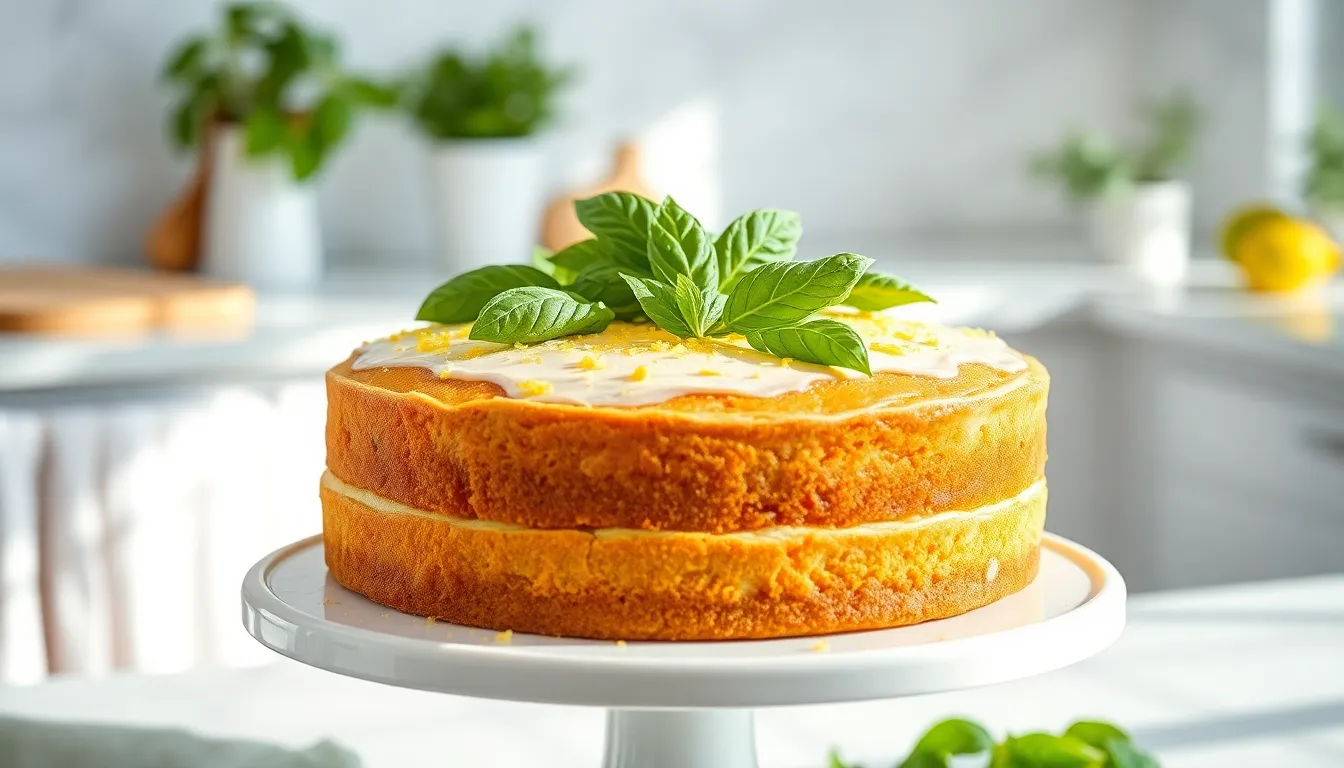
Planning ahead for special occasions can save you valuable time and reduce day-of stress. Basil cake components can be prepared in advance with proper techniques to maintain freshness and flavor integrity. Follow these guidelines to ensure your cake tastes just as amazing when made ahead:
Preparing Cake Layers in Advance
Bake your basil cake layers up to 3 days before assembly and store them properly for optimal results. Once completely cooled wrap each layer individually in plastic wrap followed by a layer of aluminum foil to lock in moisture. Store at room temperature if using within 24 hours or refrigerate for longer freshness. The resting period actually enhances the basil flavor as the aromatic oils have more time to permeate throughout the crumb.
For extended storage freeze the wrapped layers for up to 1 month. Place the wrapped cakes in freezer-safe bags and remove as much air as possible. Thaw frozen layers overnight in the refrigerator before unwrapping to prevent condensation from making the cake soggy.
Make-Ahead Frosting Tips
Prepare the basil cream cheese frosting up to 5 days ahead and store in an airtight container in the refrigerator. The basil infusion becomes more pronounced during storage creating a deeper flavor profile. Before using refrigerated frosting allow it to come to room temperature for about 30 minutes then re-whip for 1-2 minutes to restore its fluffy texture.
For the freshest presentation add the finely chopped basil to the frosting no more than 24 hours before serving. This preserves the vibrant green color and prevents oxidation that might dull the appearance.
Fully Assembled Cake Timeline
A fully assembled basil cake can be completed 1-2 days before serving with proper storage. The cake actually tastes better on day two as flavors meld and develop more complexity. After frosting place the cake in a tall cake container and refrigerate immediately.
Remove the cake from refrigeration 1-2 hours before serving to allow it to reach room temperature which significantly enhances the aromatic basil notes. Add any final garnishes like fresh basil leaves or lemon zest just before presentation to maintain their visual appeal.
Tips for Transport and Display
When transporting a pre-made basil cake use a cake carrier with a secure lid and place it on a flat surface in your vehicle. Consider bringing final garnishes separately to add at your destination. For warm weather transport place a few ice packs around (not touching) the cake carrier to maintain proper temperature.
Set up your display location away from direct sunlight or heat sources that could melt the frosting or wilt fresh basil garnishes. This advance preparation strategy allows you to enjoy your gathering without last-minute baking stress while still presenting a showstopping basil cake with perfectly developed flavors.
Perfect Pairings
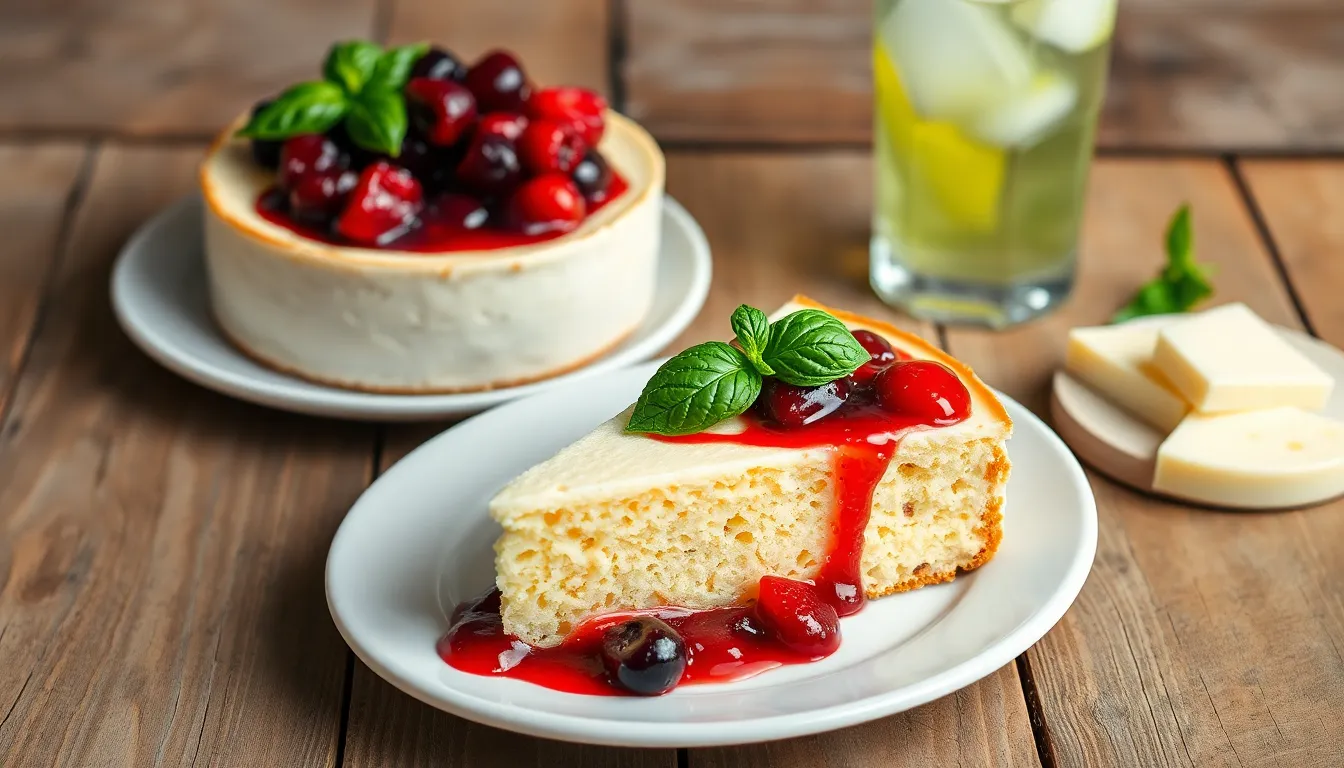
Elevate your basil cake experience with these complementary flavor combinations that enhance its unique herbaceous profile. The aromatic quality of basil creates opportunities for unexpected yet harmonious pairings that transform this dessert from special to extraordinary.
Fresh berry compote provides an ideal counterpoint to the herbaceous notes in your basil cake. The slight acidity and natural sweetness of strawberries raspberries or blackberries balance the cake’s complexity while adding vibrant color to each plate. Simply macerate two cups of mixed berries with a tablespoon of sugar and a squeeze of lemon juice for a quick accompaniment.
Citrus-infused beverages cut through the richness of cream cheese frosting while amplifying the basil’s brightness. A chilled glass of lemon iced tea or a sparkling lemonade with muddled basil leaves creates a refreshing palate cleanser between bites. For adult gatherings consider serving prosecco with a splash of limoncello to echo the cake’s lemony undertones.
Vanilla bean ice cream serves as a creamy neutral base that allows the cake’s unique flavor to shine. The cold contrast against a slightly warmed slice of basil cake creates a sensory experience that highlights different flavor dimensions. For an elevated touch infuse your homemade ice cream with a subtle hint of honey.
Herbal teas complement the aromatic qualities of this distinctive dessert. Chamomile offers floral notes that enhance basil’s more delicate aspects while a mint tea brings out its freshness. Serve these teas either hot or iced depending on the season with a small sprig of fresh basil as garnish.
Cheese plates featuring mild varieties make surprisingly good companions to basil cake. A small portion of mascarpone or ricotta drizzled with local honey creates a sophisticated dessert flight. This pairing works particularly well when the cake is served in smaller portions for formal gatherings.
Coffee preparations with nutty undertones balance the herbaceous character of the cake. A medium roast with notes of hazelnut or almond complements without overwhelming the delicate basil flavor. Avoid darker roasts that might compete with rather than complement your dessert.
Seasonal stone fruits grilled and lightly sweetened provide warmth and caramelized notes that contrast beautifully with the cake’s green herbaceous profile. Brush halved peaches apricots or plums with honey warm them on the grill and serve alongside for a summer dessert that celebrates garden abundance.
Conclusion
Basil cake stands as a testament to culinary creativity where savory meets sweet in perfect harmony. This remarkable dessert transforms a common herb into something extraordinary that will surprise and delight your guests.
The vibrant green flecks throughout the tender crumb don’t just look beautiful—they deliver an aromatic experience that evolves with each bite. Whether you stick with the classic recipe or experiment with seasonal variations your basil cake will be a conversation starter.
Remember that this versatile dessert only improves with time as the flavors deepen. Pair it with complementary elements like fresh berries citrus drinks or a scoop of vanilla ice cream to create a truly memorable dessert experience.
Your journey into herbaceous baking begins here—embrace the unexpected and enjoy every aromatic slice!
Frequently Asked Questions
What makes basil cake different from regular cakes?
Basil cake uniquely combines herbaceous flavors with sweet elements, creating a sophisticated taste profile that surprises the palate. Fresh basil leaves infuse the batter with aromatic oils, resulting in complex flavor notes that complement rather than overwhelm the sweetness. The vibrant green specks throughout make it visually striking and conversation-worthy, while the cake maintains a tender, slightly dense crumb that enhances the basil flavor.
Can I use dried basil instead of fresh?
No, dried basil won’t work well for this recipe. Fresh basil is essential as it provides the aromatic oils and vibrant flavor that make this cake special. Dried basil lacks the same bright notes and would impart a different, less desirable flavor profile. For best results, use vibrant green basil leaves from your garden or farmers market.
How long does basil cake stay fresh?
When properly stored in an airtight container in the refrigerator, basil cake remains fresh for up to 5 days. Interestingly, the basil flavor actually intensifies within the first 24 hours after baking, making it taste even better on the second day. For longer storage, you can freeze the cake for up to 3 months, tightly wrapped to preserve quality.
Can I make this cake ahead of time?
Absolutely! You can bake the layers up to three days in advance and store them well-wrapped at room temperature or refrigerated. The frosting can be made up to five days ahead and refrigerated. A fully assembled cake tastes best when made 1-2 days before serving, as this allows the basil flavors to develop more fully while maintaining the cake’s moisture.
What pairs well with basil cake?
Basil cake pairs beautifully with fresh berries, citrus-infused beverages, vanilla bean ice cream, and herbal teas like chamomile or mint. For a sophisticated dessert course, serve with a small glass of limoncello or alongside a mild cheese plate. Seasonal stone fruits like grilled peaches also complement the herbaceous notes wonderfully.
Can I add other herbs or fruits to the recipe?
Yes! The recipe is versatile and welcomes creative additions. Try combining basil with mint or lemon thyme, or incorporate seasonal fruits like strawberries or peaches into the batter or as filling between layers. Citrus zests, nuts, and even a splash of herbal liqueur can enhance the cake’s flavor profile while maintaining its sophisticated character.
Is this cake difficult to make?
No, this cake follows standard baking techniques. The only special step is creating a basil paste to infuse the batter properly. With basic kitchen tools like mixing bowls, a mixer, cake pans, and measuring equipment, even intermediate bakers can successfully create this impressive dessert. Just follow the step-by-step instructions carefully for best results.
Should basil cake be served cold or at room temperature?
Room temperature is ideal for serving basil cake. This allows the full spectrum of basil flavors to come through and the texture to soften perfectly. Remove the cake from refrigeration about 30-60 minutes before serving to let it warm slightly. The aromatic qualities of the basil will be more pronounced at room temperature.
